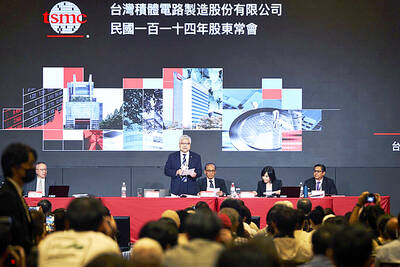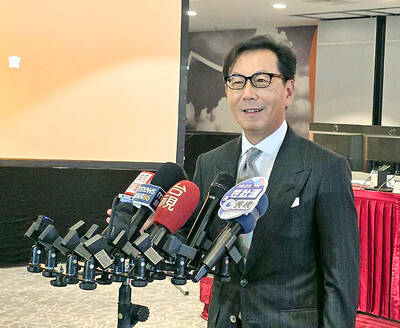On a vast farm dotted with oak and cork trees, about 350 pigs are enjoying the final weeks of a short, but blissful life. They roam freely, sleep outdoors or shelter in spacious pigsties. Above all, autumn is when they get to feast all day on acorns recently fallen from the trees.
“Pigs are known for eating everything, but when it comes to their favorite acorns, they are real connoisseurs and very selective — and the sweeter the acorn, the better,” said Juan Carlos Dominguez Lorenzo, 49, who was born on the farm and has been looking after its pigs since he was a teenager.
The way these pigs of Spain’s Iberico breed are fed and raised here is a far cry from how most meats are produced almost anywhere, making the cured ham a delicacy prized for its unique texture and taste, which is enhanced by the sweet and nutty flavor of the acorns the pigs eat.

Photo: Reuters
So when the WHO, in a recent report, linked processed meats to colorectal cancer, the news came as an affront to many Spaniards, who have been eating cured hams produced this way for generations.
Spain’s Iberico hams are increasingly sought after worldwide, particularly among Chinese consumers concerned about the safety of their own homegrown food.
“Spanish ham is a very unique product, but it’s also seen as healthy, which is a real asset when you’re selling to the Chinese,” said Oliver Win of Olivier Pacific Ltd, a fine foods distribution company based in Hong Kong that imports the Cinco Jotas brand of Spanish ham.
Indeed, Spain’s producers took no small measure of umbrage at the WHO’s attempt to lump their luxury ham together with cheaper products like processed sausages and hamburger meat.
A single leg of the finest ham from Cinco Jotas — weighing almost 18 pounds (8.2kg) — costs about US$670 in Spain. (In the US, the price is about double.) Even the way the ham is sliced is considered something of an art form.
“This ham is as natural as food can get — no added heavy metals, preservatives or colorings — and it comes from an animal that has built up muscle by eating the best food and exercising a lot in beautiful surroundings,” said Jose Gomez, the owner of Joselito, another top brand of ham. “There are thousands of products that present a higher cancer risk.”
With a passion for pork products and rising incomes, the Chinese have entered the market for Iberico hams with gusto, even while paying slightly more for Spanish ham than prices set for the US market. The next step, according to Spanish producers, is to get China to lift a cumbersome restriction that forces them to remove the bone from the leg.
In fact, the Chinese appetite for Spanish pork stretches all the way down its production chain, including innards that Spanish companies struggle to export to many Western countries.
Fresh pork exports to China from Spain — including heads, ears and other parts — rose 35 percent last year, making it the second-largest market in volume after neighboring France, according to figures from the Spanish Meat Export Office.
Last year, Fosun International (復星國際), one of China’s largest financial and industrial conglomerates, bought a stake in the parent company of Cinco Jotas, one of Spain’s top brands of Iberico ham, which is based in Jabugo.
“We generally think that our culture is closer to that of America, but when it comes to ham, Chinese gastronomy is really in tune with ours,” Cinco Jotas general director Bernardino Rodriguez said during a tour of cellars, where legs of ham are hooked from the ceiling and left to age.
“I can’t think of anybody more capable of distinguishing between different qualities of ham than the Chinese,” he said.
The finest Iberico ham is produced in southwestern Spain, a region that also has strong weather changes.
For instance, Jabugo has some of Spain’s heaviest rainfalls, resulting in a damp winter climate that helps spread the salt into the meat as it is cured, using a method dating to Roman times. The hot summer months, in contrast, favor the so-called sweating and drying of the ham.
“If you don’t have the right climate, you simply can’t produce,” Gomez said. “Ham is a bit like wine, because several small steps and adjustments make all the difference between an average product and premium quality.”
The growing Chinese fascination with the hams has also been helped by an increase in Chinese visitors to Spain, where they have the opportunity to taste firsthand the nation’s wide array of pork-related gastronomy.
“We open at 1pm, and the first clients who then cross the door are now almost certainly Chinese,” said Jose Maria Ruiz Benito, the owner of the eponymous Jose Maria restaurant in Segovia, famous for its roasted suckling pig.
As a result, some producers are also wary about sharing their skills with China. A few years ago, Spain already had to pressure the Chinese authorities to stop some producers from breaching copyright rules by labeling their ham as “Jabugo.”
“My worry is that the Chinese are willing to import today so that they can work out how to produce their own great ham tomorrow,” said Ricardo Sanchez, managing director of Arturo Sanchez, a Spanish producer.
For now, however, the idea that his pigs will end up on Chinese plates seems very remote to Dominguez Lorenzo, the farmer.
“I make everything right for these pigs, and if that work is recognized on the other side of the world, that’s just fine,” he said.
He then turned toward his pigs and produced a loud “tuueeeeh” to draw their attention, before leading them, almost like a shepherd, toward another clump of trees in search of freshly fallen acorns.

CAUTIOUS RECOVERY: While the manufacturing sector returned to growth amid the US-China trade truce, firms remain wary as uncertainty clouds the outlook, the CIER said The local manufacturing sector returned to expansion last month, as the official purchasing managers’ index (PMI) rose 2.1 points to 51.0, driven by a temporary easing in US-China trade tensions, the Chung-Hua Institution for Economic Research (CIER, 中華經濟研究院) said yesterday. The PMI gauges the health of the manufacturing industry, with readings above 50 indicating expansion and those below 50 signaling contraction. “Firms are not as pessimistic as they were in April, but they remain far from optimistic,” CIER president Lien Hsien-ming (連賢明) said at a news conference. The full impact of US tariff decisions is unlikely to become clear until later this month

GROWING CONCERN: Some senior Trump administration officials opposed the UAE expansion over fears that another TSMC project could jeopardize its US investment Taiwan Semiconductor Manufacturing Co (TSMC, 台積電) is evaluating building an advanced production facility in the United Arab Emirates (UAE) and has discussed the possibility with officials in US President Donald Trump’s administration, people familiar with the matter said, in a potentially major bet on the Middle East that would only come to fruition with Washington’s approval. The company has had multiple meetings in the past few months with US Special Envoy to the Middle East Steve Witkoff and officials from MGX, an influential investment vehicle overseen by the UAE president’s brother, the people said. The conversations are a continuation of talks that

CHIP DUTIES: TSMC said it voiced its concerns to Washington about tariffs, telling the US commerce department that it wants ‘fair treatment’ to protect its competitiveness Taiwan Semiconductor Manufacturing Co (TSMC, 台積電) yesterday reiterated robust business prospects for this year as strong artificial intelligence (AI) chip demand from Nvidia Corp and other customers would absorb the impacts of US tariffs. “The impact of tariffs would be indirect, as the custom tax is the importers’ responsibility, not the exporters,” TSMC chairman and chief executive officer C.C. Wei (魏哲家) said at the chipmaker’s annual shareholders’ meeting in Hsinchu City. TSMC’s business could be affected if people become reluctant to buy electronics due to inflated prices, Wei said. In addition, the chipmaker has voiced its concern to the US Department of Commerce

STILL LOADED: Last year’s richest person, Quanta Computer Inc chairman Barry Lam, dropped to second place despite an 8 percent increase in his wealth to US$12.6 billion Staff writer, with CNA Daniel Tsai (蔡明忠) and Richard Tsai (蔡明興), the brothers who run Fubon Group (富邦集團), topped the Forbes list of Taiwan’s 50 richest people this year, released on Wednesday in New York. The magazine said that a stronger New Taiwan dollar pushed the combined wealth of Taiwan’s 50 richest people up 13 percent, from US$174 billion to US$197 billion, with 36 of the people on the list seeing their wealth increase. That came as Taiwan’s economy grew 4.6 percent last year, its fastest pace in three years, driven by the strong performance of the semiconductor industry, the magazine said. The Tsai